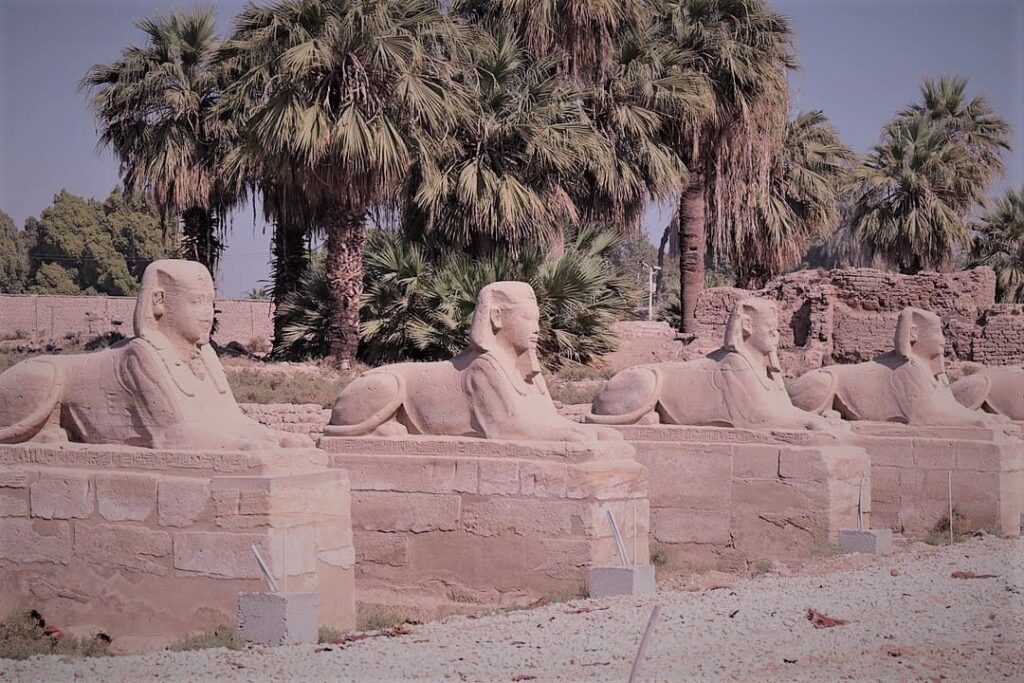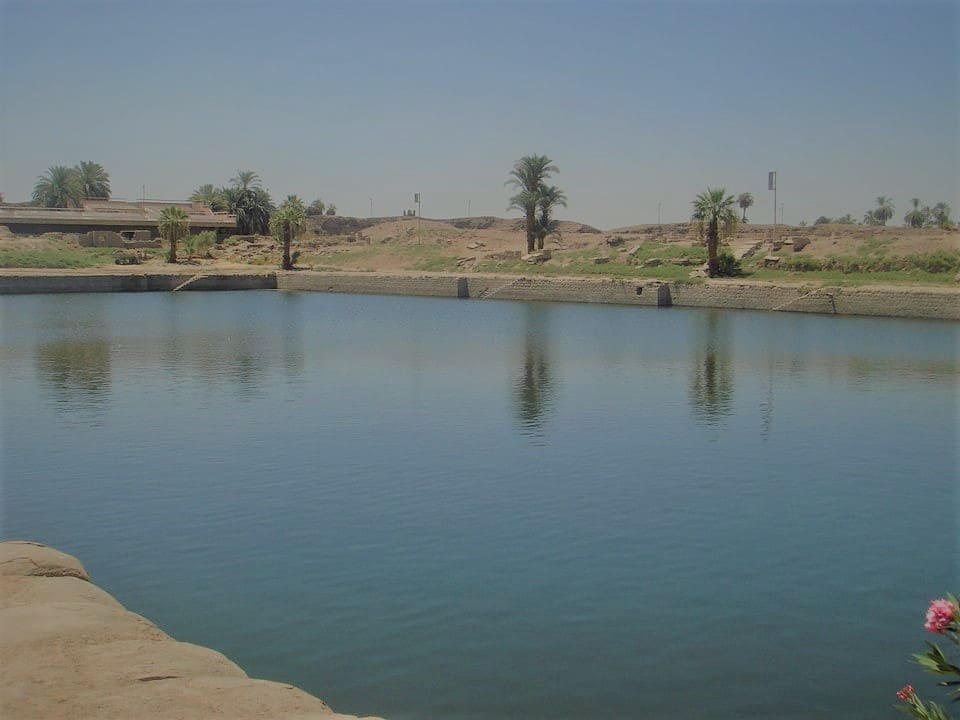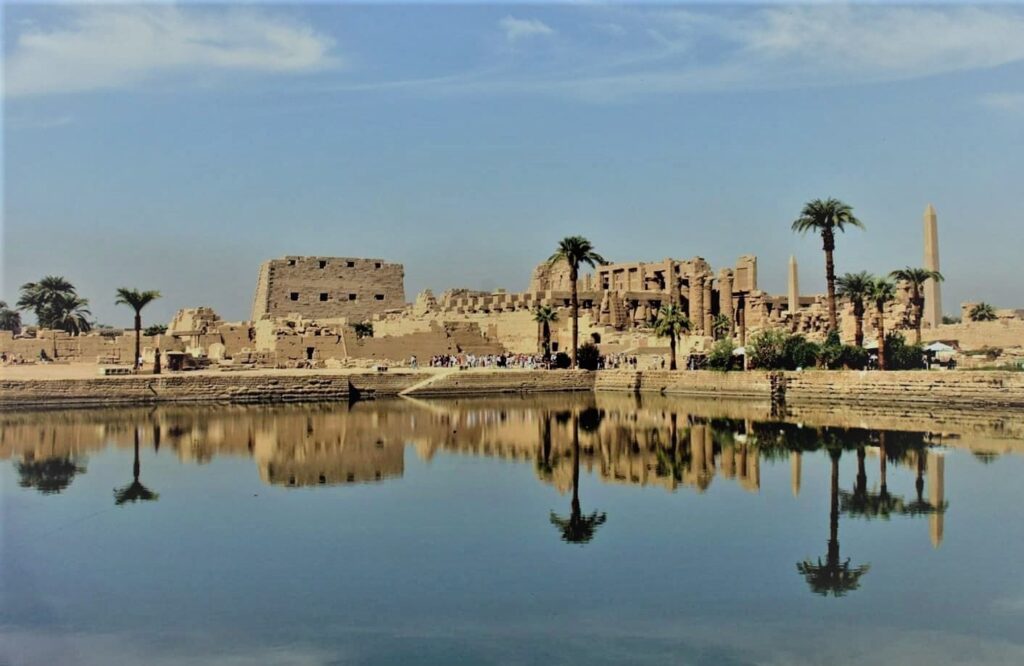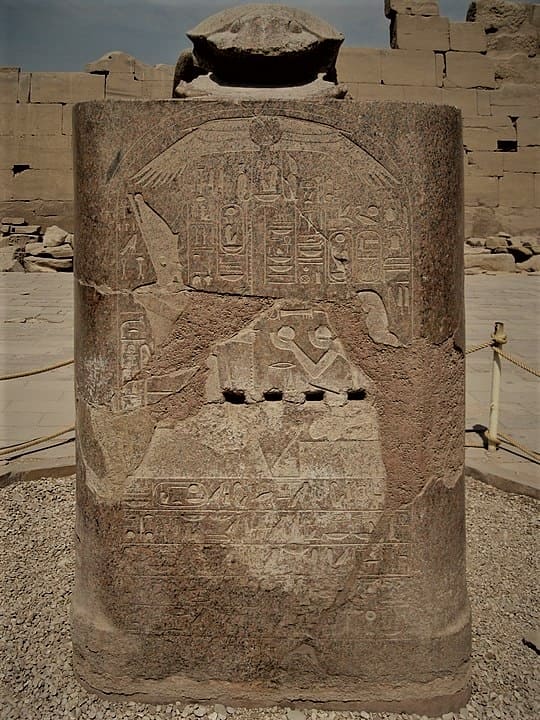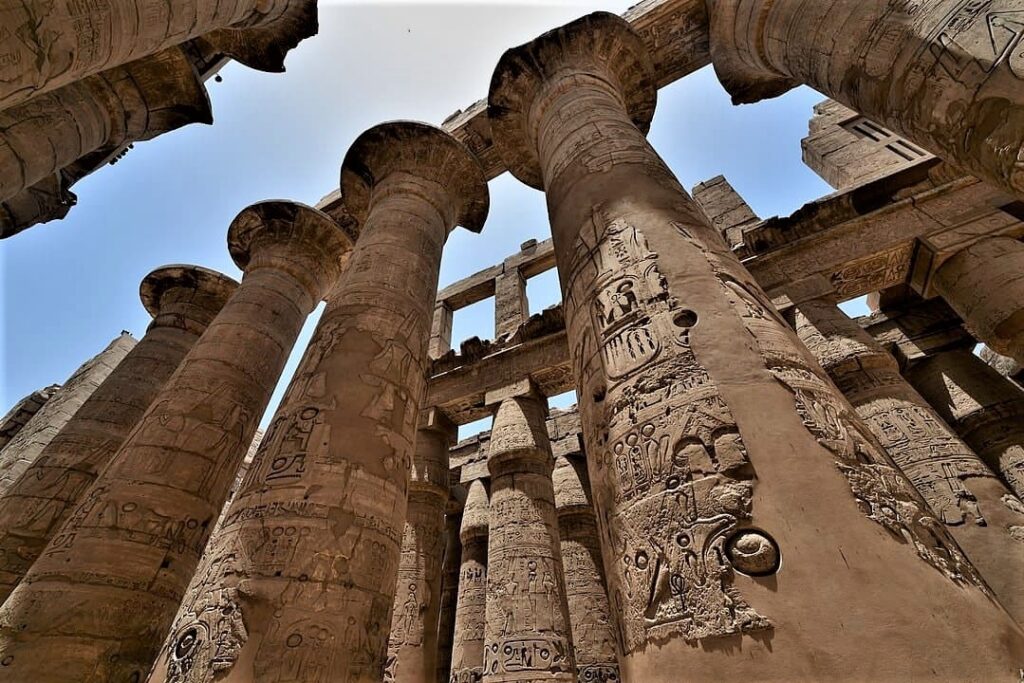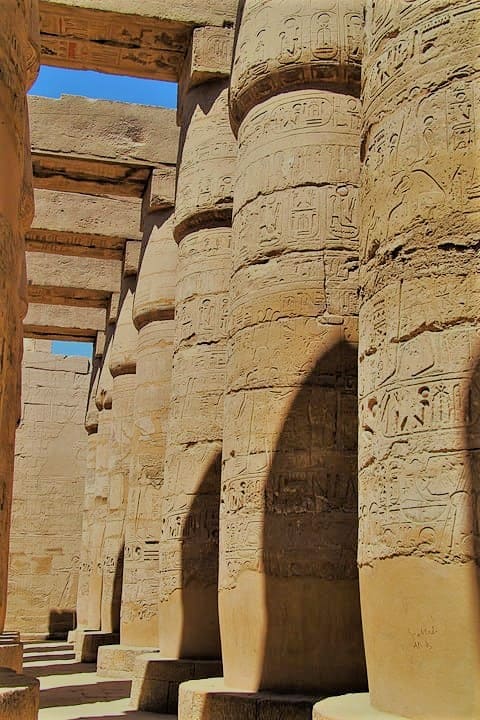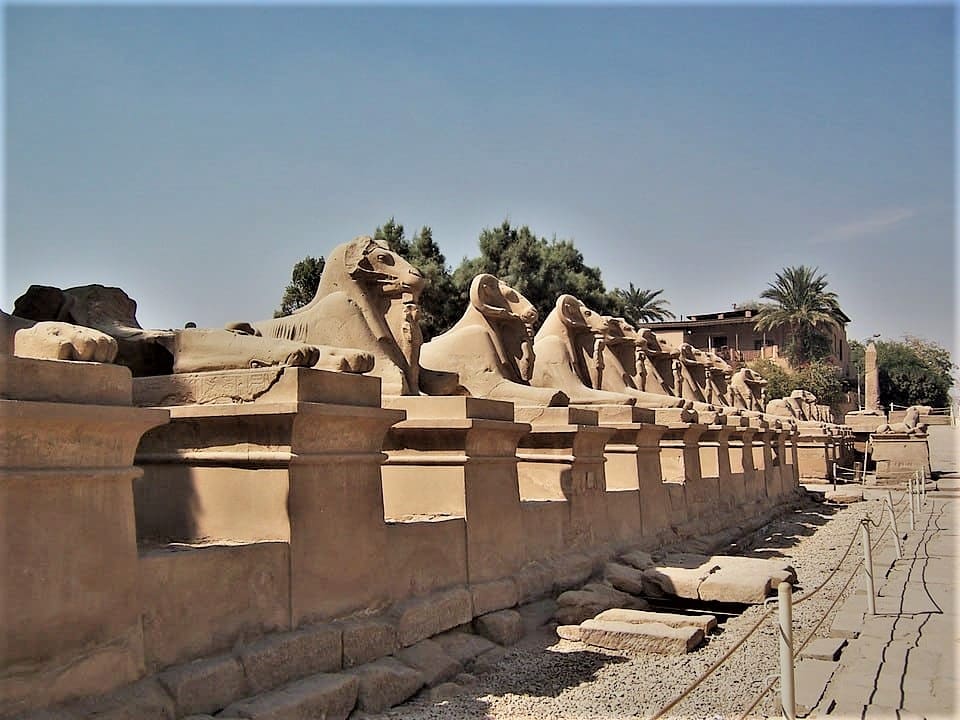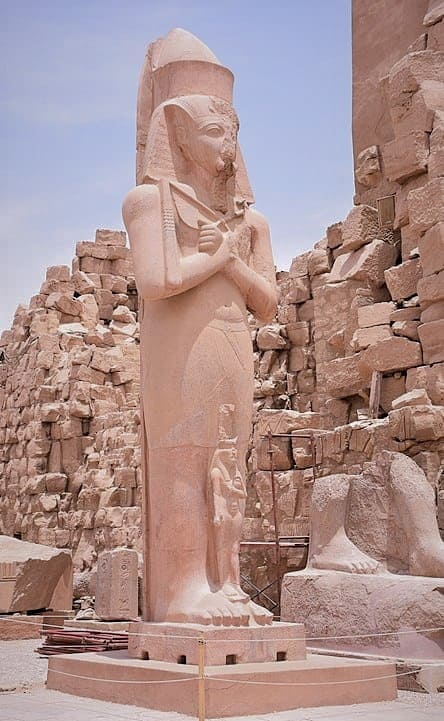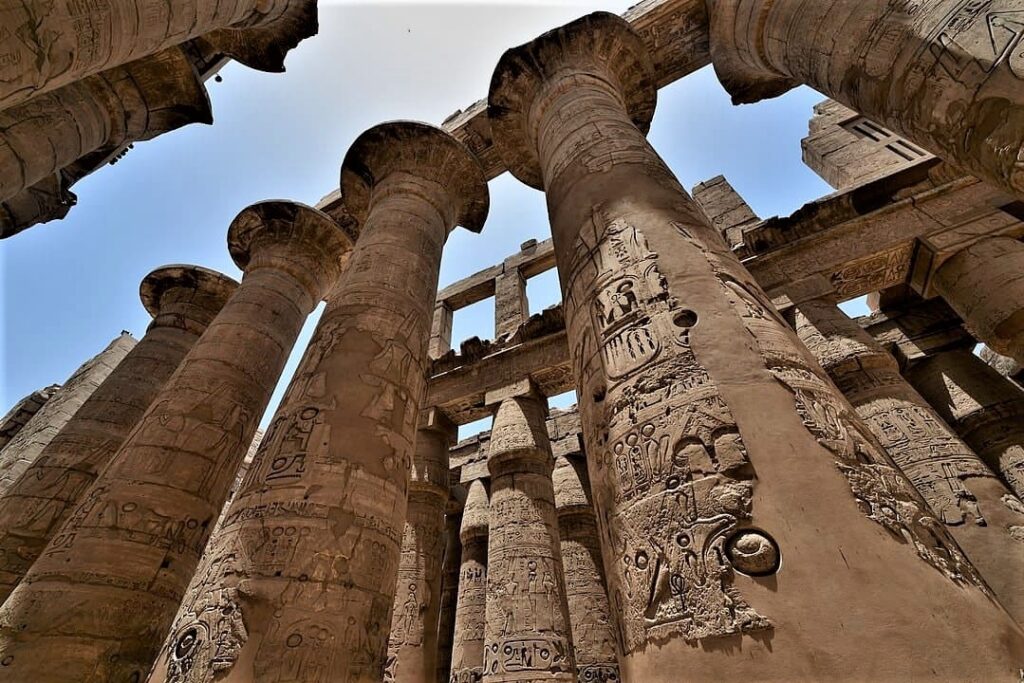
About
The Karnak Temple Complex, commonly known as Karnak (/ˈkɑːr.næk/, originally derived from Arabic: خورنق Khurnaq «fortified village), comprises a large mixture of ruined temples, pylons , chapels and other buildings near Luxor, Egypt. Construction of the complex began during the reign of Senusret I (reigned 1971–1926 BC) in the Middle Kingdom (c. 2000–1700 BC) and continued through the Ptolemaic Kingdom (305–30 BC). .B.C.) continued, although most of the existing buildings date from the New Kingdom. The area around Karnak was the ancient Egyptian Ipet-isut («The Choicest Place») and the main place of worship for the Theban Triad of the 18th dynasty, headed by the god Amun in
It is part of the monumental city of Thebes and was inscribed along with the rest of the city on the UNESCO World Heritage List in 1979.The Karnak complex gives its name to the nearby and partially enclosed modern village of El-Karnak which is 2.5 km away
Overview
The complex is a large open space and includes the Karnak Open Air Museum. It is believed to be the second most visited historical site in Egypt; only the Giza pyramid complex near Cairo receives more visits. It consists of four main parts, only the largest of which is currently open to the public. the only part most visitors see. The other three parts, the Mut Enclosure, the Montu Enclosure and the Dismantled Temple of Amenhotep IV are closed to the public.
There are also some smaller temples and shrines connecting the Mut District, Amun-Re District and Luxor Temple. Mut’s Enclosure is very old, dedicated to a deity of earth and creation, but has not yet been restored. .The original temple was destroyed and partially restored by Hatshepsut, although another pharaoh built it around him to change the focus or orientation of the sacred area. Many parts may have been adopted for use in other buildings.
The main difference between Karnak and most other temples and sites in Egypt is the period in which it was developed and used. Temple construction began in the Middle Kingdom and lasted until the Ptolemy period. About thirty pharaohs contributed to the buildings, giving them a size, complexity, and variety found nowhere else. Few of Karnak’s individual features are unique, but the size and number of features is overwhelming. worshiped much later in the history of ancient Egyptian culture.
Although destroyed, it also contained an early temple built by Amenhotep IV (Akhenaten), the pharaoh who later celebrated an almost monotheistic religion he founded, prompting his court and religious center to be moved away from Thebes. It also includes evidence of adaptations in which ancient Egyptian buildings were used by later cultures for their own religious purposes.
Hypostyle Hall
A famous aspect of Karnak is the Great Hypostyle Hall in the Enclosure of Amun-Re, a 50,000 square foot (5,000 m²) hall area with 134 massive pillars arranged in 16 rows. One hundred and twenty-two of these columns are 10 meters (33 ft) high and the other 12 are 21 meters (69 ft) high and more than 3 meters (9.8 ft) in diameter. The architraves on these columns weigh an estimated 70 tons. These architraves may have been raised to this height with crowbars.
This would be an extremely slow process and it would also require great balance to reach such great heights. A common alternative theory of how they moved is that the great ramps were constructed of sand, mud, brick, or stone, and the stones were then hauled up the ramps. If stone had been used for the ramps, much less material could have been used. The top of the ramps would presumably have used wooden rails or cobblestones to pull the megaliths.
There is an unfinished pillar in a secluded spot that indicates how it would have been completed. The final carving was done after the drums were placed so as not to damage them when placed. Various Experiments Elsewhere, mobile megaliths have been made using ancient technologies, some of which are among the largest monoliths in the world. In 2009, UCLA launched a website dedicated to digital reconstructions of the Karnak Complex and other virtual reality resources. then during the winter solstice.
Main parts Of Temple
- Precinct of Amun-Re
This is the largest enclosure in the temple complex and is dedicated to Amun-Re, the supreme deity of the Theban triad. There are several colossal statues, including the figure of Pinedjem I, which measures 10.5 meters (34 feet). ) High. The sandstone for this temple, including all the pillars, was transported 100 miles (161 km) south down the Nile from Gebel Silsila. It also has one of the largest obelisks, weighing 328 tons and 29 meters high.
- Precinct of Mut
This complex is located south of the new Amen-Re complex and was dedicated to the mother goddess Mut, identified as the wife of Amun-Re in the 18th dynasty Theban triad. It has several smaller temples attached to it and has its own sacred lake built in the shape of a crescent. This temple was devastated, many parts were used in other structures. Following excavation and restoration work by the Johns Hopkins University team led by Betsy Bryan (see below), the Mut site was opened to the public. 600 black granite statues were found in the courtyard of his temple.
Possibly the oldest part of the site. In 2006, Betsy Bryan presented her findings from a festival that appeared to involve deliberate binge drinking. The attendance at the feast was excellent, including the priestesses and the populace. There are historical records of tens of thousands of festival goers. These finds were made in the Temple of Mut, for as Thebes rose to greater prominence, Mut absorbed the warrior goddesses Sekhmet and Bast as some of its aspects.
First Mut became Mut-Wadjet-Bast, then Mut-Sekhmet-Bast (Wadjet merged with Bast), then Mut also assimilated Menhit, another lion goddess, and his adopted son’s wife, and became Mut-Sekhmet- Bast-Menhit and eventually became Mut-Nekhbet. Temple excavations at Luxor uncovered a «drunkenness portico» built into the temple by Pharaoh Hatshepsut at the height of their twenty-year reign. In a later myth, developed around the annual drunken festival of Sekhmet, she was created by Ra, the then Upper Egyptian sun god, from a fiery eye of her mother to destroy the mortals who plotted against him (Lower Egypt). In the myth, Sekhmet’s blood thirst was not quenched until the end of the
battle and caused it to destroy almost all of humanity, so Ra had tricked them by coloring the Nile as red as blood (the Nile turns red every year when it silts up in floods) for Sekhmet to drink. The trick, however, was that the
The red liquid was not blood but beer mixed with pomegranate juice to make it look like blood, which made her so intoxicated that she gave up slaughter and became an aspect of gentle Hathor. The complex intertwining of deities happened over thousands of years. of culture.
- Precinct of Montu
This part of the page is dedicated to the son of Mut and Amun-Re, Montu, the god of war of the Theban triad. It is located north of the Amun-Re complex and is much smaller. It is not publicly available.
- Temple of Amenhotep IV
The temple that Akhenaten (Amenhotep IV) built on the site was to the east of the main complex, outside the walls of the Amun-Re compound. It was destroyed immediately after the death of its builder, who had attempted to defeat the powerful priesthood that had gained control of Egypt prior to his rule. It has been demolished so completely that its full extent and layout are currently unknown. The priesthood of this temple resumed their powerful position as soon as Akhenaten died and were instrumental in destroying many records of his existence.
You Can View Our Karnak Tours NowEuropean knowledge of Karnak
The exact location of Thebes was unknown in medieval Europe, although both Herodotus and Strabo give the exact location of Thebes and how far down the Nile one has to go to get there. Maps of Egypt based on the 2nd century mammoth by Claudius Ptolemy. Geographia circulating in Europe since the late 14th century, all showing the location of Thebes (Diospolis). Nevertheless, several European authors of the 15th and 16th centuries who only visited Lower Egypt and published their travelogues, such as Joos van Ghistele and André Thévet, placed Thebes at or near Memphis.
Some of the three hundred crocodile mummies that have been discovered in the area are on display at the Crocodile Museum. In April 2018, the Egyptian Ministry of Antiquities announced the discovery of the head of the bust of Roman Emperor Marcus Aurelius during works to protect the site from groundwater. In September 2018, the Egyptian Antiquities Ministry announced that a sandstone statue of the Sphinx had been discovered in the temple. The statue, which is approximately 28 cm wide and 38 cm high, probably dates from the Ptolemaic dynasty.
The Karnak temple complex is first described in 1589 by an unknown Venetian, although his account does not give a name for the complex. This account, preserved in the Biblioteca Nazionale Centrale di Firenze, is the first known European mention since ancient Greek and Roman writers of a wide range of monuments in Upper Egypt and Nubia, including Karnak, the Luxor Temple, the Colossi of Memnon, Esna, Edfu , Kom Ombo, Philae and others. Karnak («Carnac») as a city name and complex name is first attested in 1668 when two Capuchin missionary brothers, Protais and Charles François d’Orléans, were traveling through the area. Protais’ notes on his voyage were published by Melchisédech
Thévenot (Relations de divers voyages curieux, 1670s – 1696 editions) and Johann Michael Vansleb (The Present State of Egypt, 1678).
The first drawing of Karnak is found in Paul Lucas’ 1704 travelogue (Voyage du Sieur Paul Lucas au Levant). It’s fairly inaccurate and can be quite confusing to modern eyes. Lucas traveled to Egypt between 1699 and 1703. The drawing shows a mixture of the Enclosure of Amun-Ra and the Enclosure of Montu, based on a complex surrounded by Ptolemy III’s three massive Ptolemaic Gates. Euergetes / Ptolemy IV Philopator, and the massive The 113 m long, 43 m high and 15 m thick first pylon of the Amun-Re.Karnak complex was built successively by Claude Sicard and his travel companion Pierre Laurent Pincia (1718 and 1720– 21), Granger (1731) visited and described. , Frederick Louis North
(1737–38), Richard Pococke (1738), James Bruce (1769), Charles-Nicolas-Sigisbert Sonnini de Manoncourt (1777), William George Browne (1792–93) and finally by several scholars on Napoleons Expedition, including Vivant Denon, during 1798–1799.
Claude-Étienne Savary describes the complex in great detail in his 1785 work; especially given that it is a fictional account of a fictional trip to Upper Egypt, compiled from information provided by other travelers. Savary visited Lower Egypt in 1777–78 and also published a treatise on it.
-
 Espectáculo de luz y sonido en el templo de Karnak47.00 €
Espectáculo de luz y sonido en el templo de Karnak47.00 € -
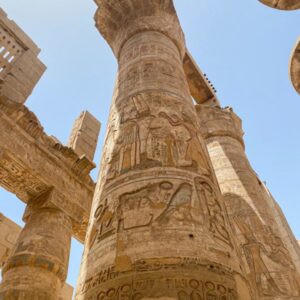 Templo de Karnak y Luxor en una visita guiada0.00 € – 55.00 €
Templo de Karnak y Luxor en una visita guiada0.00 € – 55.00 €

